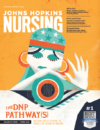Push to improve infant care earns hospital baby-friendly designation
A nurse’s capstone project spurred The Johns Hopkins Hospital to finalize its certification as a baby-friendly facility—a designation that less than 20 percent of hospitals in the country have achieved.
Joan Diamond, MSN, RN, a registered nurse and nurse manager at the hospital, will complete her Doctor of Nursing Practice degree in May. For her final project, she tackled one of the requirements to earn the baby-friendly designation: one hour of uninterrupted skin-to-skin contact between baby and mother immediately after birth, with an emphasis on breastfeeding.
Illustration by Eva Bee
The Baby-Friendly Hospital initiative was launched by the World Health Organization and the United Nations Children’s Fund in 1991 to recognize birthing centers that offer an optimal level of care for infant feeding and mother-baby bonding. Earning the baby-friendly designation is a rigorous and lengthy process, one the hospital’s obstetrics department had been working toward for several years.
Diamond proposed that the pathway to achieving the skin-to-skin requirement was a team of pediatricians, obstetricians, staff nurses, physicians, lactation consultants, and administrators working together to rewrite the hospital’s newborn care policy based on medical and nursing evidence for superior care.
Nurses were engaged “to redesign how they could best support mothers to nurse their babies,” Diamond says. “Strong evidence supports these practices, but we continued to do things differently because we have checklists.”
Now, newborns are no longer taken to a central nursery after birth. Instead, nurses delay assessments until after the first hour of life. Immediately necessary procedures, such as attaching the name bracelet, are handled during skin-to-skin contact. After the first hour, the baby remains in the mother’s room. Babies given immediate skin-to-skin contact have been shown to not only more effectively breastfeed but also maintain a more normal body temperature and heart, breathing, and glucose rates. For mothers, it can trigger maternal instincts more quickly.
Early adopters, such as perinatal staff nurse Katharine Giancola, RN, took on extra shifts and worked nights and weekends to bring peers up to speed.
“It’s one thing to be on board with it and another to put it into practice, so we invited staff to watch us put the babies skin-to-skin with mothers,” said Giancola, also a certified lactation consultant. “On the night shift, nurses might get the information, but only through emails. They needed someone to be there at night for practical, hands-on application.”
Hopkins nurses also took an additional 20 hours of training on how to teach and support new moms in the logistics and benefits of breastfeeding.
“Most of us in the obstetrics world knew about baby-friendly, but it seemed like a far-reach,” Diamond said of the designation, awarded in late December. “We needed to do this.”

